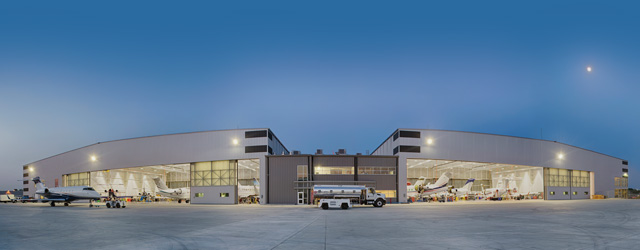
Just as our maintenance hangars rose up and changed the face of our Lincoln, Nebraska, location, we’re always looking for ways to take our processes to the next level, to rise to the occasion and exceed our customers’ expectations.
Nearly 20 months after Duncan Aviation broke ground on a new maintenance hangar complex at its Lincoln, Nebraska, facility, the hangar is bustling with activity.
The 175,000-square-foot facility, comprising of two 40,000-square-foot maintenance hangars and 95,000 square feet of office and shop space, provided even more shop and work area for services that cover most business aircraft.
The expansion was needed to meet customer requests and changing customer needs.
“We needed the additional hangar space to stay flexible enough for all of our customers. Before, we might not have been able to schedule a long-range jet for a smaller job because we already had several light jets with full interiors and airframe inspections scheduled,” explains Chairman Todd Duncan.
As the industry continues to shift toward larger business aircraft, a trend fueled by technological advances and increased globalization, Duncan Aviation’s previous hangars were unable to accommodate the volume of maintenance, modifications and completions work our customers require.
“The additional space let us rework some of our service logistics and create a more efficient work environment, consequently providing better service to our customers,” says Todd. “We’ve also been able to accommodate more drop-ins.”
Though the entire structure wasn’t officially open until May 2014, the north hangar was complete and full of aircraft in early January.
“To properly prepare for the opening, we strategically located, hired and trained additional technicians throughout 2013, building up our teams,” says Airframe Services Manager Chad Doehring. “We’ve continued to do so the same this year.”
During Team Leader Troy Nail’s 13 years at Duncan Aviation, he’s seen a lot of changes—and one immediately recognizable change is the size of the facility. His Challenger airframe team was one of the first to start work in the new maintenance hangar.
As Duncan Aviation has grown and expanded over the last 58 years, the company added buildings and hangars all around the Lincoln Airport. With the investment in the new hangars, all areas of the company were evaluated and a plan to reorganize and relocate departments and teams for more efficient workflow was developed.
For example, the Bombardier Challenger and Global airframe teams will pair up in the south hangar bay (Hangar H) and Dassault Falcon teams will share resources in the north hangar (Hangar G).
“It just makes sense to have the same programs together so we can share tools, equipment and other resources,” says Troy.
Troy says before the move, with aircraft spread among six hangars and schedules changing by the minute, it was difficult to ensure each technician had the tool he needed when he needed it. Now, with hangars grouped by aircraft make and model and increased supplies, the necessary tools are a few feet away instead of a few hangars away.
In addition to the scheduling and team changes, the facility itself is much more comfortable to work in. Heated floors make for a much warmer environment during bitter Nebraska winters, and the LED lighting combined with the skylights and abundant windows create a lighter and brighter space.
Of course, customers are requesting faster and faster turntimes on their aircraft. And more aircraft in general means more team members, so Duncan Aviation is capitalizing on all its resources to turn aircraft in record time. Not only is the company adding team members, it is changing hours for several existing team members, allowing for more work to be done on second and even third shifts.
“We’re increasing the size of our teams so we can have more people work on the second shift,” says Troy. “Adding more skilled technicians to alternative shifts helps ensure we complete an aircraft on or before the delivery date.”
With the reorganization of teams, Duncan Aviation’s new hangar facility also provides the engine line shop with its own dedicated space. Previously, engine line mechanics worked on the hangar floor; they now have their own custom 4,050-square-foot shop. (In addition to the 20,000 square foot TFE731 engine MPI shop.)
“Now when aircraft come and go, the aircraft hangar moves don’t affect us. We don’t have to move; we can just keep everything in one location until the job is done,” says James Prater, manager of turbine engine services.
After just a few months, James says he’s seen significant increase in work efficiency. The new shop space provides a dedicated place for engines to be torn-down and built up that is free from unnecessary interruptions.
That extra time has allowed technicians to focus on customer service and faster turntimes.
“More and more in-house customers are stopping by the shop to see their engines. I’m available to answer their questions or assist the engine techs with a project. Then I’m right back on the phone answering questions from customers who call in,” says Shawn Schmitz, turbine engine tech rep.

Duncan Aviation team members celebrated the maintenance hangar expansion with a variety of business aviation partners on July 15 with a full day of informational sessions, tours of the campus and visits with industry vendors and OEMs. The event concluded with an evening reception with music, food, drinks and socializing.